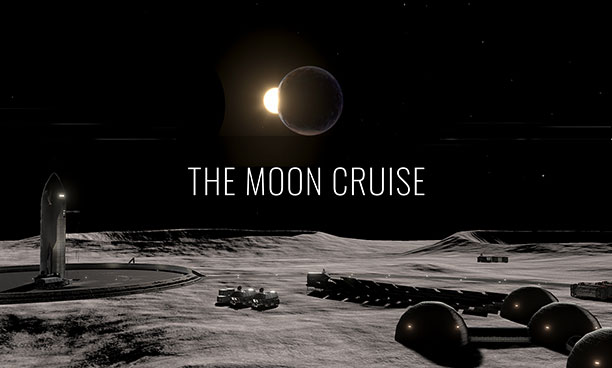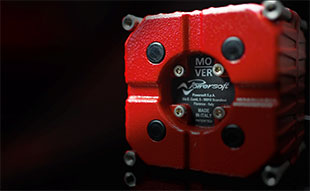
Offering visitors an immersive VR journey to the moon, a view of Earth from space, and the opportunity to walk on the lunar surface and take souvenir photographs, The Moon Cruise VR installation has opened its doors to the public in Tokyo – with Powersoft taking a stellar role.
The Moon Cruise is a free-roaming VR installation permanently installed in a new facility themed around ‘space travel’ called Space Travelium TeNQ. The space entertainment facility has permanent and special exhibits, as well as workshops to provide visitors with a single world-view learning experience,’ says Tsuyoshi Nomura, executive officer at STYLY Inc, the company charged with the technical design of the experience.
The brief was to create an ambitious VR experience that simulates the universe, all within the existing architecture. ‘The area we oversaw is permanently installed, free-roaming VR experience. There are many event-style virtual reality environments, but nothing like this has been permanently installed on such a large scale,’ Nomura says.
Managed by Audio Visual Communications Ltd, the installation simulates a rocket launch and a lunar exploration. ‘It transforms limited physical space into boundless virtual environments,’ says Audio Visual Communications Deputy General Manager, Ken Yamada. ‘The rocket launch scene, uses Powersoft Mover transducers and amplifiers, combining sound vibration and VR visuals in an unforgettable sensory experience. Our goal was to provide a realistic experience and surprise visitors.’
However, creating a convincing rocket launch experience in a confined and low-maintenance environment originally posed some challenges. According to Nomura, traditional large-scale motion platforms were impractical due to their size, maintenance requirements and safety concerns: ‘It was necessary to take a different approach, and we achieved both goals by designing new, easy-to-maintain fixtures and combining them with Mover.’
 Powersoft’s compact Mover is a low-frequency direct-drive/tactile transducer adaptable to various purposes. It lets audiences feel the sound through haptic perception by vibrating the surrounding environment, which the human body picks up, and through bone conduction, stimulates the inner ear, translating the vibrations into perceivable frequencies. Yamada explains that the ‘Mover’s compact design, flexibility, ease of installation, and impressive power’ made it the ideal solution for this installation.
Powersoft’s compact Mover is a low-frequency direct-drive/tactile transducer adaptable to various purposes. It lets audiences feel the sound through haptic perception by vibrating the surrounding environment, which the human body picks up, and through bone conduction, stimulates the inner ear, translating the vibrations into perceivable frequencies. Yamada explains that the ‘Mover’s compact design, flexibility, ease of installation, and impressive power’ made it the ideal solution for this installation.
To provide a synchronised sensory experience for the rocket launch, five Mover ID transducers are installed into bench seats, delivering powerful vibrations replicating the low frequency from BEC IC-120 loudspeakers to create a cohesive audio-tactile effect. The MoverIDs are powered by Quattrocanali 1204 DSP and Duecanali 804 DSP amplifiers, provided by v, Powersoft’s Japanese distributor. This set-up ensures a realistic rocket launch experience by combining audio and tactile feedback with virtual reality content to create an immersive journey to the moon.
For the content design, Nomura emphasises the importance of the journey visitors take on foot to their destination.
‘The narrative centres around travelling to the moon, focusing particularly on the path to the lunar surface. By emphasising the impact and experience at the departure point, it makes the visual-only walking on the lunar surface afterward feel more realistic. Since the entire facility provides a learning experience, the content encourages the visitors to reflect and act independently, rather than only focusing on the story,’ he explains.
The collaboration between STYLY Inc and Audio Visual Communications was integral to the project’s success. According to Yamada, initial tests showed that Mover provided stronger vibration from bone-conduction effects than competitor products. Additionally, the ability to apply sub-harmonics with the Quattrocanali and Duecanali amplifiers was appealing, allowing for the reproduction of the ultra-low frequencies, necessary for rocket reproduction, without the need for additional equipment.
Vibration and sound are not separable,’ he says. ‘During an actual rocket launch, unimaginable vibrations and energy from the loud noise would impact the body. Mover, which vibrates with the sound source and transmits vibrations in sync with the powerful sounds that are linked with the visuals, makes it possible to create an experience that feels as if you are actually launching into space.
‘With Mover, we were able to provide the best experience possible and combined with the content design, we achieved our client’s initial request.’
From liftoff to moon landing, The Moon Cruise offers a gravity-defying experience and brings the thrill of space travel within arm’s reach of the visitors.












